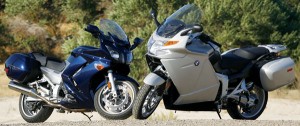 As any reader understands, the test rider has got to be objective in his evaluation of a motorcycle, to judge that motorcycle on the basis of the market for which it is intended, not allowing his or her biases to show. As I am an avowed advocate of sport touring, I am entirely capable of dedicated objectivity, and loved prepping for this comparo of the BMW K1200GT and Yamaha FJR1300A with a couple of thousand miles on-board each bike. But since it is a comparo, I also get to be pleasantly subjective in my estimation of the various individual functions of each.
As any reader understands, the test rider has got to be objective in his evaluation of a motorcycle, to judge that motorcycle on the basis of the market for which it is intended, not allowing his or her biases to show. As I am an avowed advocate of sport touring, I am entirely capable of dedicated objectivity, and loved prepping for this comparo of the BMW K1200GT and Yamaha FJR1300A with a couple of thousand miles on-board each bike. But since it is a comparo, I also get to be pleasantly subjective in my estimation of the various individual functions of each.
These are two stupendously powerful and great-handling sport-touring motorcycles, either of which any enthusiast should be glad to have in his or her garage. We did not include others for this test such as the Honda ST1300 because they have not changed in a while, and this new pair is currently at the top of the power and performance heap and deserve a focused game of one-on-one. Kawasaki’s 2008 Concours 14 was not yet available for testing.
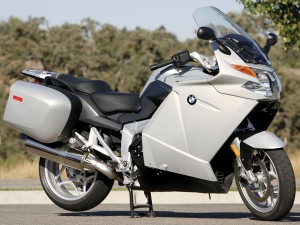
Both of these bikes are new for 2006, and there is no difference in the 2007 versions other than colors. Their similarities are clear, right down to both the K1200GT and FJR1300A sporting the same tires, Bridgestone Battlax BT020s, a 180/55-17 at the rear, 120/70-17 on the front. Both have the same type of DOHC, liquid-cooled, transverse in-line four with EFI and DOHC, 16-valve cylinder heads, and counterbalancers to minimize vibration. Both have a wheelbase of close to 61 inches. Both have a curb weight of about 670 pounds; these are big boys, and if one tips over in a parking lot, the picker-upper will know.
Of course the differences are quite fundamental as well. One is price, but we’ll deal with that later. The most apparent difference is the aesthetic, and this is where subjectivity comes in. The GT’s fairing may have been “aerodynamically optimized,” but I like the looks of the FJR’s better. Perhaps the GT is sharper at slicing through the air at 150 mph, but since I rarely indulge in such extreme behavior I prefer the more angular, more revealing FJR version. The GT is too enclosed to suit me, whereas the FJR allows a small glimpse of the interior, the engine. And I like the two middling-sized mufflers on the FJR, as opposed to the single big canister on the GT.
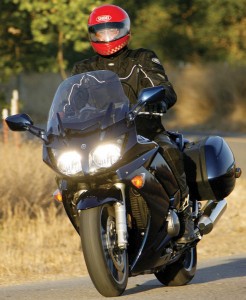
For drivetrains, the FJR has a 1,298cc engine, with cylinder bores of 79mm and a stroke of 66.2mm. The fuel injection operates through four 42mm throttle bodies, the compression ratio is 10.8:1, and the factory claims 141 horsepower at the crankshaft. The more realistic rear-wheel reading is 125.1, with 89.5 lb-ft of torque. Exhaust runs through catalytic converters in order to keep the Greenies happy. I did feel a very minor buzz in the handlebars at high rpm, but it’s nothing I would complain about.
The GT has 1,157cc, with a bore and stroke of 79 and 59mm. Its BMS-K fuel injection system uses four 46mm throttle bodies, with the compression ratio a hefty 13:1. While the company specs boast of 152 horsepower at 9,500 rpm, the rear wheel only sees 131.3 of them, and 84 lb-ft of torque. The factory has retuned the GT engine a touch from the sporting K1200S version, dropping a few ponies while increasing the torque slightly, more in line with sport touring rather than racing. The engine also runs cats to keep global warming under control.
Further differences are also interesting. The GT uses a dry sump, with the oil tank beneath the seat and a clear hose indicating oil level, while the FJR has a wet sump and oil sight glass. The shorter-stroke GT engine redlines at 10,000 rpm, the FJR at 9,250‚Ķat which point the motorcycle is going very, very fast. For me, throttle in hand, straight road ahead, once the tach reads over 6,000 on either of these machines, I am pretty much along for the ride. I’m competent for upward of 100 horsepower, and beyond that the swoosh and thrust are admittedly great fun, but I don’t want to be leaning over at 40 degrees barreling through a curve at 120 mph.
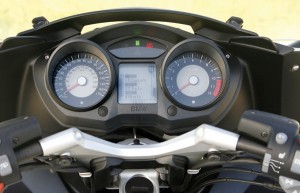
Both drivetrains use a hydraulically actuated multiplate clutch, and then have shaft drive to the rear wheel. The difference is in the transmissions, as the FJR has five gears, the GT an added sixth gear in the box. Both have gear indicators up on the dash, which I thoroughly appreciate. I have been guilty of inadvertently running the GT in fifth gear for 50 miles of freeway, while sometimes (as with most multis) reaching for a sixth gear on the FJR. The jury is out on the perfect number of gears, though I’d rather have a sixth and not need it than the alternative.
Both bikes suffer from an overly abrupt off/on throttle reaction, which I really disliked. This made it very hard to be smooth in the twisties, backing off on each curve, then throttling on. Motorcycle engineers have been mucking about with fuel injection for in-line four-cylinder engines ever since the Kawasaki KZ1000 Classic of 1980, and I would think they would have this done right by now-but not so with these two. A rider can learn to live with this jerkiness, but it would be so much nicer not to have it.
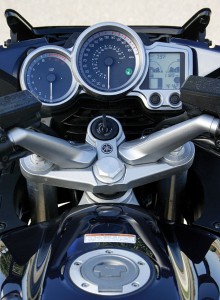
I did like the FJR’s driveline better, as our test GT suffered from a clunky transmission and driveline lash. When I was concentrating on my shifting everything was fine, but if I were lackadaisical around town or in traffic, I would be reminded that BMWs have long been famed for their rustic gearboxes.
What was impressive was the low-end torque of both machines. I could be down at 2,000 rpm and smoothly motor away without shifting gears. This I loved, as will anybody who finds himself pottering along slow-going country roads. According to the dyno roughly 80 percent of the engine’s torque is available from 3,000 rpm to nearly redline in both bikes, and that is all to the good. These are torquey monsters, which is the advantage of their large engines. In touring terms, few riders will be interested in 131 horsepower, but 90 lb-ft of torque mean a lot.
The original FJR got a lot of complaints about engine heat roasting the rider, but that has been fixed with the major revamp for 2006. There is a whole new “Air Management System,” and a heat shield has been placed beneath the gas tank. Some warmth does emanate down low, around the rider’s ankles, but it is nothing unpleasant. Unless one is wearing sandals and shorts. BMW, perhaps because it was plagued by a heat problem on the old K100 bikes back in 1984, addressed these things early on and I couldn’t feel any unpleasant heat at all on the GT.
The biggest difference between the two is in the chassis, not so much the frames themselves, but the suspension units. Both have frames of hollow cast aluminum from which the engine and tranny are suspended. BMW, priding itself on being different, has equipped the new K series with its Duolever front end, which has less of the normal dive than is found with telescoping front forks. It works well, and never did anything I did not like, but I actually enjoy the feel of a conventional fork under hard braking as it tells me what is happening down at the front wheel-that is subjective stuff. The rear Paralever has a centrally mounted single shock absorber and single-sided swingarm. Our test GT had the optional $800 Electronic Suspension Adjustment system, and anybody who buys the BMW and does not opt for that is downright foolish, in my mind. It really is nice to be able to go from COMFORT to NORMAL to SPORT damping on the fly at the push of a button, or just as easily change the spring preload when stopped.
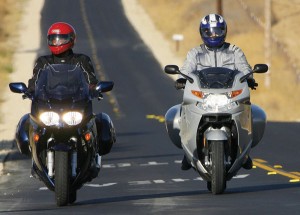
In truth I’m not much of a suspension fiddler, generally setting it to my liking and letting it go at that. The FJR has a very good set of suspenders, with three-way adjustability of the 48mm SOQI front fork (preload, compression and rebound damping), and two-way adjustment for the rear shock (preload and rebound damping), all of which are easily done. I took possession of the FJR with the standard factory settings, and found the ride a mite soft. The shock has just two spring preload positions, SOFT and HARD, which takes literally one second to adjust, and I preferred the latter. I also upped the rear damping by three clicks, and tightened up the fork a little and left it there. If I knew I was going to be futzing around town for a while, I would slip the rear preload back to SOFT.
With some reasonably aggressive riding in the SPORT mode I did not get the BMW to drag anything in corners at all. The original FJR had a definite problem with cornering clearance, but with this 2006 model’s rear suspension set on HARD, and the rebound damping up three clicks, I had to try very hard to get the feelers on the footpegs to touch, and I couldn’t get anything solidly mounted to scrape.
Both bikes have ABS-assisted triple disc brakes as standard, with partially integrated braking application, and both are capable of stopping the bike very, very quickly. BMW is to be commended for using stainless-steel braided brake lines, but continues to complicate its system with the power-assist, which I do not like at all. I felt I got better feedback from the FJR than the GT. I know that BMW means well, and is trying to give the rider as much braking as possible, but this power-assist is not the way to go about it in my opinion. I don’t like the whining noise it makes when sitting at a stoplight, either.
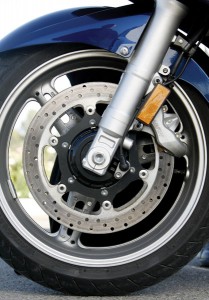
How about those triangulated ergonomics-bars, seat, pegs? Both seats have two positions, and I found-being long of leg-that the upper position is slightly more comfortable. Both have adjustable handlebars, the GT’s going up, the FJR’s pivoting. The FJR’s pegs seem to be set forward a little farther, making it easier for me to stand up when approaching an unlevel crossing. There are enough adjustments to the ergonomics on both bikes that most any rider should find contentment. Granted, a 5-foot, 3-inch 120-pounder may find the bikes a bit too big, but that is only natural.
Electrically operated windscreens are nice to have, especially when you see the wipers on approaching cars moving. Both screens created more noise around my helmet when up, but did good jobs in keeping the elements at bay. I don’t like how the FJR’s windscreen retreats to its nesting position whenever the ignition is turned off. There it would be, at just the right height, and then I stop for something-zoop! I was told there is a wire that can be cut to prevent this silliness, but I did not cut it. Another FJR quirk is the lack of automatic canceling for the turn signals, which seems a little old-fashioned in the 21st century.
Price? Big difference. The base 2007 FJR1300A price is $13,799, while the base BMW K1200GT goes for $19,025. Both come with saddlebags, and the Yamaha’s ABS-assisted brakes are standard as well. Yamaha has a short list of options, including heated grips, a tankbag and travel trunk, whereas BMW offers everything from cruise control to the GPS Navigator system, to heated seats to that excellent electronic suspension adjustment, a more powerful xenon headlight, and even a tire pressure control arrangement; these can easily add a few thousand dollars to the price tag.
Decision? As we have noted, the FJR1300A and the BMW K1200GT are very similar motorcycles, but I simply found the FJR more fun to ride, with a smoother transmission and brakes that are more to my liking. The GT is a fine motorcycle, with lots of lovely add-ons available, but I’ll take the FJR-and spend the extra five grand on a trip to the Gaspe Peninsula.
If you’re interested in the 2006 Yamaha FJR1300A, you might also be interested in Rider‘s 2008 Yamaha FJR1300A Review, or our 2009 Yamaha FJR1300A/AE Tour Test.
If you’re interested in the 2006 BMW K1200GT, you might also be interested in Rider‘s 2003 BMW K1200GT, 2003 BMW R1150RT, 2003 Honda ST1300 & 2004 Yamaha FJR1300 review comapro.







